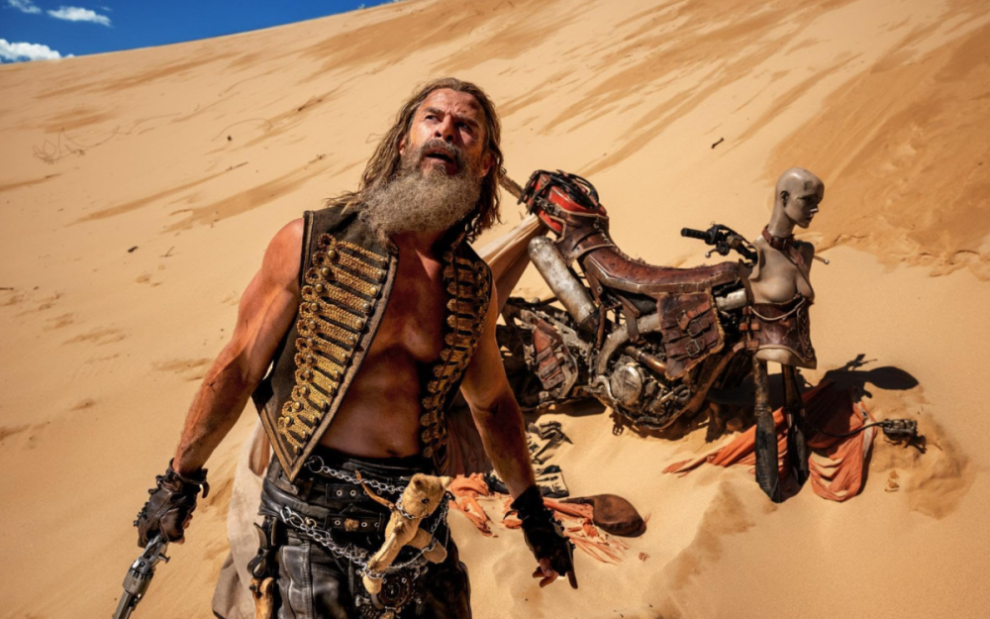Furiosa: A Mad Max Saga opens with a God’s-eye view of a fragile sliver of green in a vast expanse of rust orange: an oasis of life in the post-apocalyptic desert landscape of George Miller’s Mad Max films. How fragile the Green Place is, even its guardians don’t know. All they know is that if this place of abundance is discovered by the rapacious hordes jockeying for control of the Wasteland, that will be the end of the abundance. So, when this Eden is invaded, its guardians will go to any lengths necessary to defend it. Yet the garden’s days are already numbered; in less than two decades, the water will turn sour, and nothing will grow. The world is already broken.
Is there no hope? This desperate question hangs over the previous film in the saga, Miller’s 2015 extravaganza Mad Max: Fury Road. Now, the same question haunts Furiosa, an epic origin-story prequel for Fury Road’s stealth protagonist, Charlize Theron’s Imperator Furiosa. Here Furiosa is no less memorably realized, first as a child by Alyla Browne and then as a young adult by Anya Taylor-Joy. From the riveting opening act—a taut, fierce chase sequence resulting in Furiosa’s loss of paradise, the first of several traumatic losses in her life—Miller establishes his heroine as canny, resourceful, and single-minded in her determination to survive and find her way home again.
Following Dune Part Two and Kingdom of the Planet of the Apes, Furiosa is this year’s third dystopian sci-fi sequel set in a harsh world of warlords and conquerors striving to seize the means of production or destruction. Five years ago, secular apocalypses were everywhere in pop culture. While apocalyptic stories are still with us (e.g., the upcoming Quiet Place prequel), increasingly, the focus seems to have shifted to life after the end of the world as we know it. (Our bleak cultural moment may be perfect for the coming third film in Danny Boyle’s 28 Days Later/28 Months Later zombie series, called, of course, 28 Years Later.)
If there is such a thing as hope, these 2024 sequels seem too cynical and weary to look for it in sages, heroes, or high ideals. Once, we might have hoped that the compassion and wisdom of Andy Serkis’s super-chimp Caesar—or Oscar Isaac’s Duke Leto—would light the way forward. But no. Like the latest Dune and Planet of the Apes movies, Furiosa is ambitious and accomplished, and all three are worth seeing on the big screen. Yet a welcome humanistic spirit present in prior films is at a low ebb in this year’s installments. Moral lessons are forgotten or found wanting, and the strongmen who hold sway pervert or mock them.
Not that there were ever sages or heroes worth quoting in the Mad Max franchise, which started in 1979 with a low-budget vigilante revenge story starring Mel Gibson and grew into something more mythic. That doesn’t stop Miller’s latest outrageous villain—one Dementus, a tawdry, would-be Attila the Hun leading a horde of marauding bikers—from perverting and mocking the sort of things heroes would say, if there were any. Played by Chris Hemsworth in a prosthetic nose, Dementus swaggers around with a parachute cloak trailing behind him like a cape, looking like a cut-rate parody of the actor’s own Thor. The first time we see him, cloak draped over his head, he suggests an unpersuasive screen Jesus; he can even sound like a queasy cross between Jesus and a pandering politician: “Listen to this truth . . . come to me with your pain and burden, and I will double your grub!”
After a vivid heroine and an electric villain, Furiosa’s third key asset is, of course, the gonzo multivehicular action. Miller may never outdo (no one may ever outdo) the operatic insanity of the set pieces in Fury Road, but Furiosa plunges us persuasively back into that world of mad invention and orchestrated chaos, with inspired new visuals making the return trip worth taking. There’s heavier reliance on CGI this time around, but the tactile, visceral sense of Fury Road’s action runs through Furiosa as well.
Two standout set pieces team Furiosa with a seasoned road warrior named Praetorian Jack (Tom Burke, Mank), who works for the brutal overlord Immortan Joe (Lachy Hulme, stepping in for the late Hugh Keays-Byrne). Jack is the last thing you expect in the Wasteland: a decent man longing for an honorable destiny. “My mother and father were soldiers,” he explains in a quiet moment. “Even as the world fell, they longed to be soldiers for a virtuous cause. For them, it never happened.”
The very words “a virtuous cause” in a movie like this are a tonic to the soul. The antithesis of Immortan Joe’s toxic masculinity and brutal patriarchalism, Jack mentors and aids Furiosa selflessly, with no sign of the sort of personal motive, honorable or otherwise, that might draw a man like him to a woman like her. The closer they grow, though, the more Jack’s absence in Fury Road points in an unwelcome direction. If there is hope here, it’s only at the far side of much loss and pain.
Even so, Jack’s decency has the potential to make Furiosa the most human film in the series—though that doesn’t quite happen. Why not?
Partly, I think, it’s because the environmental and feminist themes are less explicit than in Fury Road. There’s nothing here like the earlier film’s morally evocative slogans: “Who broke the world?” and “We are not things.” We get a glimpse of the inhuman, eugenic sexual slavery of Immortan Joe’s “wives,” a set of whom will eventually escape with Furiosa, but the film misses an opportunity to establish the secret spirit of resistance that will culminate in that escape.
Hope is invoked in Furiosa mostly by Dementus—who is adamant that there isn’t any. His attitude is paralleled in Fury Road by Tom Hardy’s Mad Max: “Hope is a mistake—if you can’t fix what’s broken, you’ll go insane.” Eventually, Max warily acknowledges the possibility of hope, and even of “some kind of redemption.” “Redemption” is what Theron’s Furiosa says she’s looking for, but, unlike hope, the theme of redemption isn’t set up here.
Then there’s the climactic monologue from the History Man (George Shevtsov), an advisor to Dementus and the film’s diegetic narrator. “There always was, is, and will be war” is how the speech begins. “North against South, East against West . . . countless wars of religion and righteous belief. . . . Eyes for eyes, teeth for teeth, rage fueled by grief.” This vision of war as worldview, as the constant of history and human nature, is one person’s perspective, but it has the force of a thesis statement. Is victory in battle all we can hope for? Fury Road wasn’t a religious film, but it made room for an agnostic prayer “to anyone listening,” not to mention the spiritual journey of the War Boy Nux from religious fanaticism to humanistic solidarity. Furiosa offers nothing like this.
“Eyes for eyes, teeth for teeth, rage fueled by grief” is an apt commentary on the savage sequence that follows, turning Furiosa into a revenge story like the first Mad Max. Furiosa’s last words to Immortan Joe in Fury Road—“Remember me?”—are anticipated here. Yet where Joe’s death, though horrible, is also quick, efficient, and in the heat of battle, Furiosa has something very different in mind for Dementus.
Strikingly, Dementus has no intention of accepting his role in a revenge story by begging for his life or issuing threats. Instead, he issues a startling takedown of the whole idea of revenge: “You can never balance the scales of their suffering!” he harangues. “You will never get anything close to what you want.” In the film’s epic saga schema, with chapter headings presumably reflecting the History Man’s narration, this final sequence is called “Beyond Vengeance.”
All of this raises the hope of a revelatory denouement in some way rejecting revenge. But then Dementus challenges Furiosa, “Do you have it in you to make it epic?”—and it becomes clear that Miller wants to go beyond ordinary vengeance, crafting a comeuppance so perverse and absurd that he almost can’t commit to it. Is this parting conceit meant to fuse hatred and hope? To suggest that sufficiently ingenious vengeance can lead to new life? Is it meant to be somehow redemptive? Whatever the case, the last twist leaves a bad taste that diminishes the whole movie.
The moral bleakness is mitigated by how tightly the ending of Furiosa ties into the beginning of Fury Road. Furiosa’s story does not end in rage and revenge, and Praetorian Jack is not the last man she will learn to trust. Hope and redemption are coming. Still, future forays into the Wasteland would do well to go deeper into the question with which Furiosa opens: “As the world falls around us, how must we brave its cruelties?”
Image: Jasin Boland/Warner Bros.















Add comment